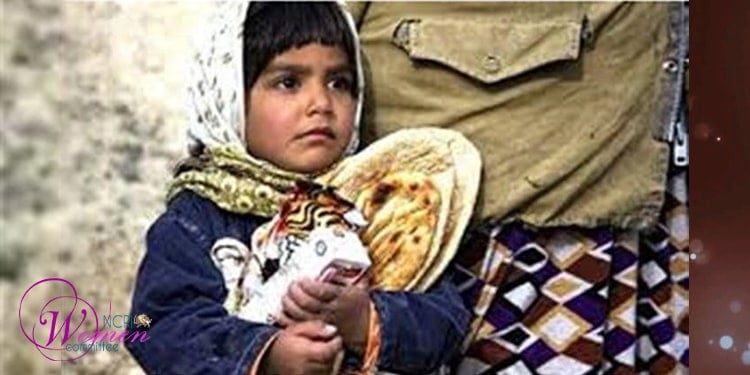Malnutrition in Iran: Thousands of Iranian girls go to bed hungry
Malnutrition has devastating effects on the human body, especially children. Long-term deprivation – over months and years – to essential nutrients causes chronic hunger or malnutrition.
Malnutrition makes the body very weak and renders it prone to a variety of physical and mental illnesses. The main reasons for malnutrition are poverty and lack of access to food.
Malnutrition is one of the most common problems in children in Iran, especially in girls under 5. The consequences of malnutrition include impaired mental and physical development, increased costs of treatment and medical care, and academic failure.
These consequences have a very destructive effect on society because the good health and positive growth of children lead to society’s future health as a whole. The nutritional status of children under the age of 5 is a good indicator in assessing a community’s health.
On the eve of the World Food Day on October 16, the NCRI Women’s Committee draws attention to the plight of girls, women and pregnant women who are the primary victims of malnutrition in Iran.
Inaccurate statistics on malnutrition in Iran and among girls
None of the regime’s official sources or news outlets provide accurate statistics on girls and malnutrition in Iran. The regime has only offered one or two examples, and their statistics are grossly inaccurate. According to data obtained by ISNA, “54,076 girls under the age of 5 use the so-called child nutrition support program” (The state-run ISNA news agency – October 12, 2018).
Actual statistics demonstrate that the number of girls who suffer from malnutrition is much higher than regime estimates. At best, the regime declares that 54,076 girls under the age of 5 are supported!
In its propaganda, the regime declares that it is providing food packages to malnourished children. However, food provision measures are occasional and limited: after a short time, the assistance stops, and children and their families are left to go hungry. Short-term donations of food baskets do not help cure malnutrition in children.
In addition to the benefits of propaganda, the regime uses the food basket program as an excuse for its officials to receive big budgets and loot the supplies.
On its official website, the Ministry of Health indicated that in Iran, there are 50,000 children under the age of 5 who are malnourished. But it is not clear how many of these children are girls (The state-run behdasht.gov.ir – September 29, 2020).
According to the report, 67,000 poor pregnant women were identified by the Health Ministry; however, many more have not been identified.
Another source reported that there are 137,000 malnourished children in Iran (The state-run Roydad-24 website – September 22, 2020).
Three years ago, the state-run ILNA news agency reported, “Currently, 200,000 children under the age of 6 are suffering from malnutrition due to poverty in the country” (The state-run ILNA news agency – May 31, 2017).
Obviously, given the rise in poverty in Iran over the past 3 years, it cannot be true that the number of malnourished children has gone from 200,000 to 50,000.
In 2020, Iran’s poverty line was declared to be 10 million tomans. Of Iran’s population of 83 million, some 60 million are below the poverty line (The state-run Tabnak website – September 20, 2020).
Provincial statistics on child malnutrition
According to government sources, children in seven Iranian provinces are more malnourished than in other provinces. Lorestan, Sistan and Baluchestan, Hormozgan, Ilam, Kohgiluyeh and Boyer-Ahmad, Kerman, and Khuzestan are among these provinces.
- 12,000 children in Sistan and Baluchestan (The state-run ISNA news agency – November 17, 2018)
- 2,300 children in Bushehr (The state-run ISNA news agency – April 24, 2019)
- 2,200 children in Yazd (The state-run ISNA news agency – July 14, 2019)
- 1,600 children in Semnan (The state-run Fars news agency – April 29, 2019)
- 1,200 children in Zanjan (The state-run ISNA news agency – July 25, 2019)
- 2,038 children in Chaharmahal-o Bakhtiari (The state-run Mehr news agency – June 27, 2020)
- 1,599 children in Ardabil (The state-run Mehr news agency – September 19, 2020)
Coronavirus pandemic and increasing malnutrition in Iran
In pregnant women and girls, malnutrition weakens their immune systems and increases the likelihood of contracting COVID-19.
“Because of the economic consequences of the Coronavirus, food insecurity and malnutrition will increase,” declared Zahra Abdollahi, Director-General of the Nutrition Department in the Iranian Ministry of Health and Medical Education (The state-run behdasht.gov.ir – September 29, 2020).
“According to surveys, between 15 and 35 percent of households in the country have eliminated or reduced their consumption of food items… Food items have been removed from the table due to declining family incomes and rising food prices,” Abdullahi added.
Who is responsible for girls’ malnutrition in Iran?
Malnutrition in Iran: Thousands of Iranian girls go to bed hungry
According to Article 24 of the Convention on the Rights of the Child, governments are responsible for malnourished children, especially girls. Governments must recognize the right of the child to receive the highest standard of health and facilities for the treatment of illness and rehabilitation.
In a society where the Velayat-e-Faqih regime sees its survival in the annihilation of Iran and Iranians, government officials do not pay the slightest attention to children, let alone girls, to protect them from malnutrition. The regime spends the Iranian people’s wealth and resources on internal repression and exporting terrorism to other countries. And the Iranian people are becoming poorer by the day, facing only empty tables and hunger.
